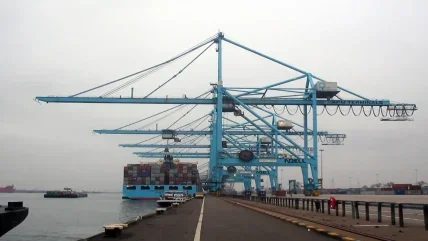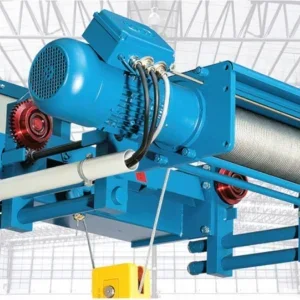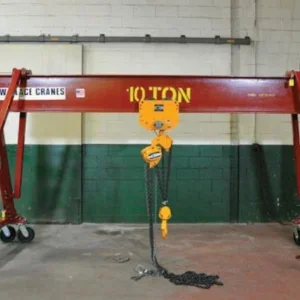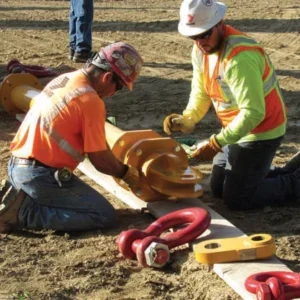
The word ‘portable’, as applied to hoists, can cover quite a lot. At one extreme Konecranes describes its CXT Explorer gantry crane – see ‘Konecranes goes exploring’ on the next page – as ‘portable’: it requires a full-sized shipping container to move it, plus another spare empty one to erect it on, but in the context of a full-sized gantry crane that can be set up within hours on a virgin stretch of beach, desert or jungle and then taken away again afterwards when the project is finished, ‘portable’ is indeed an accurate description.
At the other extreme ‘portable’ includes manual chain hoists small enough and light enough to be carried in the pocket of a work overall. Harrington Kito claim to have the “world’s smallest industrial hoist” in its CX mini hand hoist. It comes in three sizes. The quarter ton-capacity version with 10ft lift would count as the lightest and smallest: it weighs 7lbs (3kg). The one-ton capacity model weighs 17lbs (7.6kg) and the half-ton-capacity model splits the difference at 10lbs (4.5kg). Versions with 20ft of lift are also available.
Columbus McKinnon claims its Hurricane Mini 360°? as “the smallest hand chain hoist on the market with full 360°? rotation”. Those last four words mean that it does not conflict with Harrington Kito’s claim for the world title. The “full 360°? rotation” phrase means that once you have hung the CM Hurricane Mini from a suitable support, the rotatable chain cover on the hoist lets you pull on the chain from any direction rather than being limited to a straight downwards pull. You can even pull horizontally to lift a load. In a confined space this is clearly an advantage.
They may be small, but these two mini-hoists and their competitors are far from being toys; carried down mine passages and in similar hard-to-reach and confined spaces they can be invaluable in saving the operative from strenuous – and potentially back-damaging – hand-lifting when installing or repairing any sort of underground installation. All they need is somewhere to hang them from – an attachment point strong enough to take the load, which in the case of the Hurricane Mini 360?° can be up to 0.25 tons or 0.5 tons, since it comes in two versions. The smaller one weighs 2.6kg (which would actually make it lighter than the Harrington Kito CX), the larger one a tad under 4kg. The chain supplied gives a lift of 10ft, 15ft or 20ft (3m, 4.5m or 6m) depending on your application. The longer chains and higher lifts increase the overall weight that you carry with you, of course (and make a bigger bulge in your pocket).
Columbus McKinnon suggests the hoist for service technicians, construction workers, or any low-capacity on-the-job lifts in factories, field construction, agriculture, warehouse and small equipment installation.
Gantry cranes
Moving up the scale of things, portable gantry cranes are ubiquitous in almost every auto repair shop or small fabrication unit. Here ‘portable’ means ‘push-around’. Typically, a steel or aluminium beam is supported by A-frames at each end, and the A-frames are on castors allowing the whole thing to be moved around the floor space, generally by hand, to wherever it is needed. The classic use for them is lifting an engine from a vehicle but there are thousands of other applications.
Thus, for example, Caldwell supplies Krane King portable gantries, in steel or aluminium, on castors that move on any level floor. They come in fixed-height versions or with adjustable heights and spans; the H90 fixed-height model has a 3.0-ton capacity and the range goes up to 8.0-ton models that have bolt-together sections, and height and span adjustability. Heights are adjustable in 12in (300mm) increments. The largest model, the K90-8 7/24, has an inside span of up to 22ft 6.0in (6.8m).
UK company Reid Lifting, based in Chepstow, makes gantries under the name of Porta Gantry and Porta Gantry Rapide. The latter is genuinely portable, in the sense of being liftable (rather than just pushable) by one person, who can carry it from place to place – stairs or rough ground are no barrier. The lightest version weighs only 33kg when disassembled, and assembly, as the name suggests, is rapid. It involves not much more than unfolding the legs and securing them in place by ball pins, and then adjusting the height of the beam to whatever you require. A hand-powered winch fixes to one of the A-frame assemblies, and a fall arrestor to the other; the rope goes between them via the moveable trolley on the beam.
Unpacking and assembling can be done by one person in a couple of minutes. After use it can be packed away and stored or taken to the next job-site in the back of a pick-up truck.
It comes in three versions (standard, medium and tall), with heights adjustable up to 2.9m and beam lengths up to 4m, and can support loads of up to 1,000kg as well as people – for example, lowering an operative safely down a manhole (and, of course, safely recovering him afterwards.) Its load limit is 500kg for people, making it suitable for up to three persons for fall protection applications.
The standard Porta Gantry – the non-Rapide version – can also be manually assembled, using just four bolts, though the components have to be fitted together rather than just unfolded. The pay-off, though, is its much greater capacity: it is for heavy lifting, of materials up to 5t.
One suggested use for the Porta Gantry Rapide is for scenarios involving confined spaces – accessing below-ground water treatment facilities, to raise a submerged pump for servicing, for lifting and lowering equipment, or for working down manholes. That is clearly one reason that man-lifting is stressed among its abilities.
An alternative to portable gantries for such uses is the portable tripod. The Tractel Tripode, for example, is just such a temporary anchor designed to be set up over manholes and the like. It can carry the weight of two workers (weighing up to 150kg each) plus their equipment and tools and has been tested to stop their fall. It can also be used as an anchor point for lifting, with the capability to raise a maximum load of 500kg.
It is foldable. Made of aluminium, it weighs only 23.3kg without accessories and is small enough to be transported in light site vehicles. The maximum height below the head is adjustable from 1.78-2.73m and, dependent on height, the distance between the legs can be from 1.03-1.58m.
Related to man-lifting is the need for portable hoists in rescue scenarios – for example, winching casualties from the water or from cliffs after falls. Here, Tractel has an interesting variant: its de-rope hoist can be used manually, using the hand wheel, or the load or casualty can be raised by attaching a standard battery-powered electric drill to a socket in the centre of the hand wheel. A battery hand drill has ample power to lift a casualty from the water, as a video at https://bit.ly/3zyooQW shows.
In the US, Thern has also adopted the hand drill-drivable concept: several of its worm gear hand winches can be operated with a power drill – ideal, it says, for lifts where higher speed and less fatigue are required. The company suggests using, for example, a DeWalt heavy-duty right-angle drill kit, corded or cordless but in both cases heavy-duty, with an 1-1/8in socket adapter. Thern, too, has an instructional video, at https://bit.ly/3TYSw03. Its winches have handles for manual operation; for powered use simply release the handle and connect the drill in its place. Loads up to 2,500lbs (1.1 tons) can be lifted. Sample performance figures for a ED330-DW11 drill with Thern’s winch model 4WM2 and 0.25in rope diameter are loads of 1,000lbs (450kg) lifted 75ft (22m) in 10 minutes, or, a more powerful option, an ED400-DW09 drill with a similar winch model and thicker 5/16in rope to lift 2,500lbs (1,130kg) 50ft (15m) in four minutes. They have packaged kits with power drill options included. Thern does point out that these products are not rescue winches: they are not designed to lift people, or to lift things over people.
Dutch winch-maker Gebuwin is another manufacturer to have embraced the drill-powered concept. It is interesting that all three manufacturers have adopted different approaches to the end use of the idea – it is still out-of-the-box thinking, so standardised mindsets do not yet apply. Gebuwin’s unique selling point is to use a drill-powered winch to lift and tension golf nets – the nets that provide safety from mishit balls on golf courses and driving ranges. Such nets are high – 4m or more – and are heavy. The winch the company suggests is its 1,000kg worm gear battery drill winch (a smaller 200kg version is also available). To power it for the golf course application Gebuwin shows a large heavy-duty construction drill from Stihl rather than the more familiar handy toolbox item, but the principle is the same: the drill is inserted into a socket and is used to raise or lower the nets with high speed and low torque. The final tensioning of the nets, needing a higher torque, is done manually, but since few turns of the winch drum and handle are needed for this last stage it does not take much time or effort. The winch is equipped with a special flexible adaptor to absorb the vibrations of the drill.
Gebuwin also offers its more conventional cordless drill-powered Pulley Man hoist. It weighs 4kg, so is easy to carry. It has a lifting capacity of 300kg (or 600kg with a two-line fall arrangement) and a standard cable length of 12m (though it can work with up to 50m, and can pull a 1,500kg load in a winching rather than lifting mode.) A suggested application is unloading bags of building sand from the back of a pick-up truck – though, of course, a suitable overhead attachment point will need to be found unless your truck has a davit arrangement fitted. The Pulley Man can be supplied on its own, or in a complete kit that includes a cordless 18V 50Nm Hikoki-brand drill with two Li-ion batteries and charger. And, since manufacturers seem to believe that videos are necessary to show how drill-powered hoists should be used, Gebuwin has two: at https://bit.ly/3DUZiON for the golf course, and at https://bit.ly/3DxdjRc for the Pulley Man.
Actually, they have three. Since Christmas is coming, if you are feeling in need of seasonal cheer have a look at Gebuwin’s Pulley Man being used to set up the Christmas tree inside Salisbury Cathedral at https://bit.ly/3NBJ4xd. It enabled the erection of a 10m tree, which is 3m taller than could be managed in previous years when hand winches had to be used. Something to put on your Christmas list maybe?
Konecranes goes exploring
Field operations in remote areas can require hoists and lifting equipment – Konecranes has an ingenious solution in its CXT Explorer. It is a 6.3-ton capacity overhead gantry crane that is transportable in a single standard shipping container. On-site, put a second, empty, container on the ground 5m from the first, while the two of them provide a base for the assembled rig.
Set the supporting steel structure on top of the containers and secure it with twistlocks. Add the crane beam and trolley. The result is a steel framework supporting Konecranes’ CXT overhead gantry crane on top of two standard ISO shipping containers that provide both stability and clearance – in effect, a full-blown maintenance workshop ready to go. There is a 5.0m lifting height and a 5.0m span between the containers, which themselves can now double as storage units for tools, equipment and spare parts.
Assembly takes only a few hours, and you can take it almost anywhere that a shipping container can be delivered, including places that have little or no infrastructure available. A generator can power the crane if there is no on-site electricity. Vehicle maintenance is an obvious application, but construction, mining, agriculture, and oil and gas are just a few of the others. And when the project is over, dismantling it and taking it away with you is just as easy. It is a cost-effective solution to lifting in remote places and is out-of-the box (or out-of-the-container) thinking as well.
Asymmetric gantry, clay oven and basement
Bow Street Magistrates’ Court and Police Station in the heart of London’s Covent Garden was once where Edwardian man-about-town revellers were taken to be charged with drunk and disorderly behaviour after over-exuberant late-night celebrations in the surrounding nightclubs and hostelries. The historic Grade II listed building is now being converted to become the first NoMad Hotel outside the US.
As part of the transformation, commercial catering equipment had to be lowered from the ground floor to the kitchen basement, along with a cherry picker required for interior work on the building. The task called for a gantry solution that could work across two levels and in a fairly restricted space. The requirement was for a moveable gantry that could accommodate both the 5.5m height and the 800kg weight. DSM Contract Lifting Services contacted Reid Lifting’s partner Ritelift for advice.
The solution was a beam supported from the basement at one end and from the ground floor at the other. A Reid Portagantry 3000 A-Frame was assembled to its maximum 5.5m height in the basement. Another was set at 2m height on the ground floor above, and the two of them supported a horizontal beam 8.4m long running between them. Two standard trollies were fitted along with a Reid Trolley Rope Control System.
The solution was assembled quickly and easily. The oven and cherry picker were safely lowered into the basement in minutes. Because the Portagantry system allows for beams and A-Frames to be interchanged, it was possible to put together a bespoke solution using two standard gantries from the range that Ritelift hold in stock.






